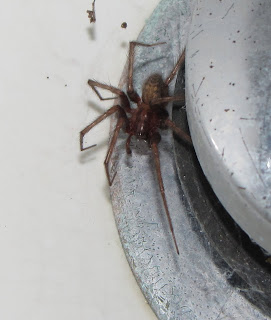This coming week, from July 20-28, 2013, is the second annual “National Moth Week” across the U.S. (and also abroad in a few places). I wrote about the inaugural event last July, and in return got some props from the organizers. Their website includes the locations of all events this year. There is at least one in every state, though not all are open to the public.
Meanwhile, “Mothapalooza” held at the Shawnee State Park Lodge in Scioto County, Ohio last month (June 14-16) was a resounding success. Over one hundred people attended, from as far away as Colorado (moi), Nebraska, and even Canada.
It was Seabrooke Leckie, co-author of the Peterson Field Guide to Moths of Northeastern North America, who came from Ontario. It was a joy to finally meet her in person. She is personable, humble, and quietly goes about the business of nudging others into an obsession with moths and other fauna. She is also one of those rare writers who can pen both fiction and non-fiction. Look for a novel from her sometime soon.
Mary Ann Barnett, the principal organizer, warmly greeted everyone upon their arrival at the lodge. I don’t think I ever saw her without a smile on her face. Her enthusiasm was contagious, and it showed in the excitement of all who went afield and attended workshops. It is no mean feat creating an event like this, especially when field outings happen around blacklights and white sheets after dark on nearly the longest day of the year. Surprisingly, no one seemed to suffer from sleep deprivation.
I was surprised by the diversity of moths that came to the lights stationed near the lodge, and other places like the Eulett Center in adjacent Adams County. My expectations were low, and I had mentally prepared myself for what I assumed would be an absence of giant silkmoths, most of which emerge in late spring. Well, I was thrilled to see four Luna Moths, a Bisected Honeylocust Moth, and a male Io moth (“eye-oh,” not the number ten, like I thought when I was a kid).
There were plenty of Waved Sphinx moths, one Abbott’s Sphinx, Walnut Sphinx, and a Pine Sphinx. Great Leopard Moths were in relative abundance as well. Painted Lichen Moths, though small, drew “oohs” and “ahs” for their snappy striped pattern. Plenty of owlet moths and geometer moths (adults of inchworm caterpillars) provided material for debates as to their proper identities.
While the nights were taken up with moth-gawking, the mornings were devoted to workshops on topics like moth identification and insect photography. Guest speakers addressed attendees on Friday and Saturday evenings after dinner. Saturday afternoon we had daytime field trips, some of which yielded day-flying moths like the Delicate Cycnia, Cycnia tenera.
Butterflies, the diurnal counterpart to most moths, were out and about, too, including the Harvester, the adult form of North America’s only carnivorous caterpillar.
Harvester larvae eat aphids, especially on alder trees.
You do not need to have a blacklight or mercury vapor set-up and a white sheet to enjoy moths. Simply turn on your porch light. Moths can be found in even the most urban situations. I found at least six species of underwing moths (genus Catocala) alone in downtown Cincinnati, Ohio when I lived and worked there in the 1990s.
Identifying moths might seem to be an overwhelming task, but with references like Seabrooke’s book (with David Beadle as co-author), and online resources like the Moth Photographer’s Group and Bugguide.net, you can easily put a name to most of the striking, colorful, and common species, if not also the more obscure and less common ones.
One word of caution, however: You are likely to become hooked on moths, and spend many nights gazing at lights, maybe even driving to rural gas stations in hopes of seeing a greater variety. Don’t be surprised if you meet others with the same inclination, flocking to lights like….well, moths to a flame.
P.S. I will be attending National Moth Week events here in Colorado and in Arizona. Watch this space for reports on both.























